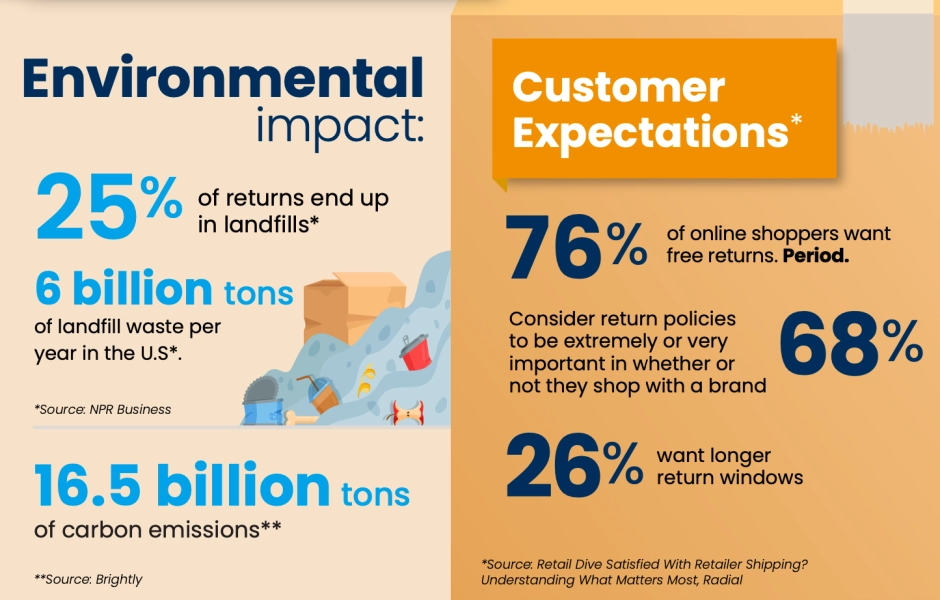Returns Management in 2024: Balancing Cost and CX
Retailers must ask how to more effectively manage returns in 2024 while balancing costs and customer experience.
Retailer’s efforts to curtail returns by charging fees and narrowing return windows paid off in 2023, as American shoppers returned 14.5% less than the year before, according to Intelligent Insider. However, for eCommerce companies, their rates increased by 1.1%, to a total of 17.6%.
This is mixed news as retailers had to face some harsh backlash from customers unwilling to accept the new parameters. One-third of the 81% of retailers that introduced friction into the returns process lost customers, and 40% saw a decrease in sales. Further, 55% of shoppers say they have abandoned their carts due to the lack of convenient returns.
Fewer returns is beneficial to retailers’ margins, but hard on customer experience. The question retailers must ask is how to more effectively manage returns in 2024 while balancing costs and customer experience. Is there a better way than eliminating free returns and cutting return windows?
The Retailer’s Perspective
Returns are expensive and wasteful. It is estimated that it costs merchants an average of $27 to process a return for a $100 eCommerce order. Of all returned merchandise, only 30% is ever resold. The rest is thrown away, donated, or sold to liquidators.
Further, the ecological cost of increased carbon footprint from packaging and transportation adds more than 16.5 million tons of emissions per year. It is estimated that 25% of returns end up in the dump — in the U.S., totaling an annual 6 billion pounds of landfill waste.
Clearly, the cost of returns in logistics, labor, transportation, repackaging, and managing returned inventory is simply not sustainable — which is why retailers decided to take action to curb the rising cost by eliminating free options. It’s obvious that a change in consumer behavior is necessary, but what is less so is whether a harsh change of policy has been the best way to go about it.
Customer Expectations
In our own study, we found that customers hold strong opinions about having their free returns taken away from them. To be fair, retailers have created a strong expectation among customers over the last decade that everything about omnichannel shopping should and will be easy. Free returns were originally part of the incentive to get people to feel comfortable ordering online, then came Amazon’s easy free return promises, and everyone else followed suit. To charge for returns even a couple of years ago made a retailer stand out — and not in a good way.
The pandemic saw a spike in online shopping — an upward climb that is expected to continue for the next few years, as this last peak season reinforced with a 6.3% YoY increase in online sales compared to 2.2% of in-store growth. The pandemic shift to eCommerce and the stay-at-home orders encouraged a surge in returned goods. When the pandemic eased and stores reopened, retailers were left with a consumer base that now had the habit of ordering online and returning goods with abandon. Margins decreased and costs skyrocketed and retailers took action: no more free returns.
Not so fast, consumers responded.
In our Retail Dive Survey, we found consumers want choices:
- 76% of online shoppers want free returns. Period.
- 64% want free returns at a store
- 26% want longer return windows
- 68% consider return policies to be extremely or very important in whether or not they shop with a brand
Consumers are not taking the lack of free returns lightly. They continue to choose brands that offer at least one free return method and favor brands that remain return-friendly.
Maintaining a Positive Customer Experience During Change
Needless to say, despite the about-face on free return policies, few retailers have taken their eyes off customer experience. It is paramount to maintain and innovate on CX. Retailers have tried to cushion the blow of no-more-free-returns by bundling free options in membership/reward programs (which helps cover the cost), offering a free-return in store, or issuing refunds while requesting the customer retain the merchandise. Brands are trying to make the change more palatable, but few have taken a truly customer-centric approach: i.e., communicate.
We dove into 7 strategies to reduce returns without losing customers in our ebook, and one of the most important ways brands can gain customer buy-in for eliminating free returns is to tell the returns story. Customers need to know the true impact of returns — and be encouraged to participate in ways to reduce it — for the good of all. Most consumers have no idea how much waste returns create, so this is one aspect that brands need to campaign around with an “in it together” mentality and call for action. People can support what they understand and have empathy for.
If your brand wants to offload return processing altogether, partner with charities that accept donations. Issue refunds while asking customers to donate their items and “pass it forward.” People are looking for ways to give and contribute meaningfully to their communities — offsetting return processing by setting up a positive, generous act of giving would have a major impact across many sectors.
The flip side of the coin is to reduce the reason that consumers need to make returns in the first place. Improve product descriptions, introduce virtual try-ons, include accurate customer ratings, reviews, images, and sizing/spec details. Get color details right. Take as much guesswork out of the shopping experience as possible so that customers can make confident, right purchases.
Lastly, as a third-party logistics partner, Radial helps manage return processing for our eCommerce customers. A 3PL partner can be an efficient way to streamline technology, partners, and operational expertise to reduce return costs while ensuring great customer experiences.
Radial can support your returns process.


